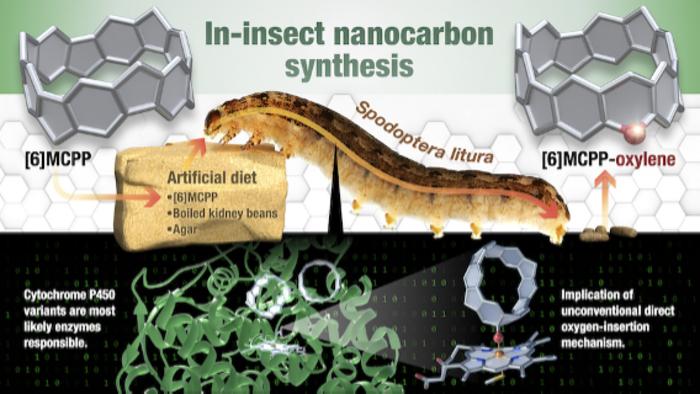In a groundbreaking development at the intersection of chemistry and biology, researchers at the RIKEN Pioneering Research Institute (PRI) and the RIKEN Center for Sustainable Resource Science (CSRS) have introduced a novel trajectory in molecular engineering by transforming insects into functional molecular factories. Spearheaded by Kenichiro Itami’s team, this revolutionary methodology—termed “in-insect synthesis”—opens unprecedented doors to synthesizing and modifying complex molecular nanocarbons within living organisms, sidestepping the formidable challenges posed by traditional laboratory techniques.
Molecular nanocarbons, minuscule carbon-based architectures with extraordinary mechanical strength, electrical conductivity, and luminescent properties, are pivotal to cutting-edge technological applications. These include aerospace engineering, where lightweight yet robust materials are essential; next-generation battery systems demanding efficient electron transport; and the ever-evolving realm of electronics, relying on precise molecular constructs for miniaturization and performance improvements. Despite their immense potential, fabricating molecular nanocarbons with exact atomic precision and altering their defined geometries has persistently vexed chemists. The delicacy of their defined shape renders conventional synthetic processes prone to compromising molecular integrity.
Intriguingly, Itami’s team drew inspiration from biological systems, conjuring the provocative hypothesis of harnessing insects—famed for their metabolic versatility—as biological catalysts. Plant-feeding insects like caterpillars and grasshoppers naturally degrade complex and toxic phytochemicals through an arsenal of enzymatic pathways in their gut. These enzymatic transformations often involve oxidations and other modifications that can be challenging to replicate synthetically. Recognizing this remarkable biochemical adaptability, the researchers envisioned employing insects as living microreactors capable of performing intricate chemical reactions on molecular nanocarbons.
To test this innovative concept, the research team administered a specially designed molecular nanocarbon compound, named [6]MCPP, to tobacco cutworm caterpillars (Spodoptera litura), notorious for their rapid lifecycle and metabolic prowess. This belt-shaped nanocarbon was chosen for its structural intricacies and amenability to biological interactions. Remarkably, after just two days of feeding, chemical analyses revealed the formation of a novel oxygen-incorporated derivative, [6]MCPP-oxylene, within the caterpillars’ excreta. This subtle oxidation event endowed the originally inert molecule with fluorescence, marking a significant functional transformation.
The elucidation of the molecular structure of [6]MCPP-oxylene relied on sophisticated analytical platforms, including mass spectrometry, nuclear magnetic resonance (NMR) spectroscopy, and X-ray crystallography. These complementary techniques unraveled the precise oxygen insertion site and confirmed the structural integrity of the nanocarbon framework post-modification. The pivotal biological agents orchestrating this rare transformation were identified as two cytochrome P450 enzymes, CYP X2 and CYP X3. Genetic analyses affirmed that disabling these enzymes abrogated the oxidative modification, underscoring their essential catalytic role.
Delving deeper into the mechanistic underpinnings, computer simulations and molecular docking studies revealed a highly unusual enzymatic interaction. These P450 enzymes were capable of simultaneously binding two [6]MCPP molecules and inserting an oxygen atom directly into a carbon–carbon bond—a chemically formidable feat rarely observed in biological systems. This enzymatic oxidation contrasts starkly with synthetic laboratory attempts, which either failed to induce the reaction or yielded only negligible amounts of the oxidized product, highlighting the unique catalytic environment within the insect gut.
This pioneering work heralds a paradigm shift in materials chemistry by integrating biological complexity into molecular manufacturing. Traditional chemistry relies heavily on controlled reactions in isolated glassware, often struggling with demanding manipulations on nanocarbon scaffolds. Conversely, the in-insect synthesis approach leverages evolved enzymatic machinery and biological environments to facilitate reactions that are otherwise chemically inaccessible. The biological context provides not only reaction specificity but also operational conditions—such as mild temperatures and aqueous media—that enhance molecular survival and functionalization.
Looking forward, the potential of this approach could be vastly expanded by coupling with modern biotechnology tools such as genome editing and directed evolution. Tailoring insect enzymes to catalyze an even broader spectrum of molecular modifications could enable the bespoke fabrication of molecular architectures with tailored electronic, optical, or mechanical functionalities. This fusion of organic chemistry with synthetic biology foreshadows a new era where living organisms become partners in molecular innovation, potentially giving rise to eco-friendly, sustainable production pathways that bypass energy-intensive industrial syntheses.
The tobacco cutworm, historically maligned as a resilient agricultural pest, assumes an unexpected heroic role in this study. Known for its prolific metabolism that confers pesticide resistance, this species demonstrates an inherent biochemical versatility that can be harnessed beneficially. The researchers reflect on this transformation from adversaries to enablers of advanced molecular synthesis as emblematic of the untapped potential residing in nature’s vast diversity.
Beyond molecular nanocarbon synthesis, this novel method prompts reconsideration of how complex organic molecules can be constructed and functionalized within living systems. The gut microbiome, enzyme diversity, and metabolic pathways of insects represent a treasure trove of catalytic possibilities, many of which remain largely unexplored by chemists. This approach challenges preconceived limits and illustrates the power of cross-disciplinary innovation—marrying entomology, enzymology, and nanomaterials science toward practical applications.
The ability to produce fluorescent nanocarbons through mild, bio-catalyzed oxidation could also inspire next-generation sensors, imaging agents, and optoelectronic devices. The molecular modifications achieved harness nature’s own selectivity and efficiency while overcoming the synthetic bottlenecks that have historically hampered scalability and functional tailoring. Moreover, in-insect synthesis might emerge as a platform technology, adaptable to other molecular targets beyond nanocarbons, potentially including pharmaceuticals, agrochemicals, and specialty materials.
In sum, the efforts by Itami and colleagues represent a visionary leap in chemical science. By transforming insects into living molecular foundries, the researchers circumvent entrenched challenges of synthetic chemistry, opening a pathway that reconciles molecular precision with biological complexity. The implications of in-insect synthesis reach far beyond isolated molecules, pointing to a future where biology and chemistry coalesce seamlessly to innovate sustainably and expansively.
Subject of Research: Animals
Article Title: In-insect synthesis of oxygen-doped molecular nanocarbons
News Publication Date: 5-Jun-2025
Web References: DOI: 10.1126/science.adp9384
References: Science, 2025, Itami et al. "In-insect synthesis of oxygen-doped molecular nanocarbons"
Image Credits: RIKEN
Keywords
Organic chemistry, Organic synthesis, Enzymes




